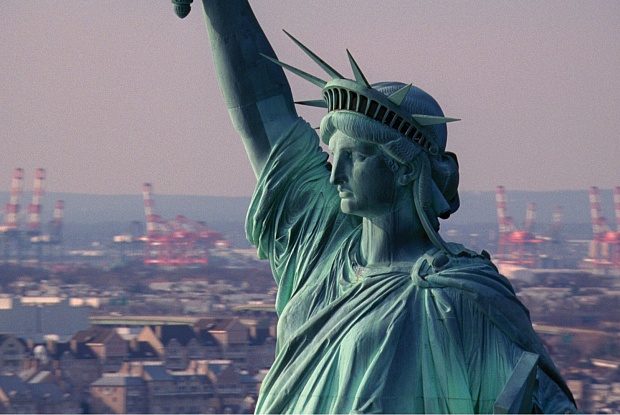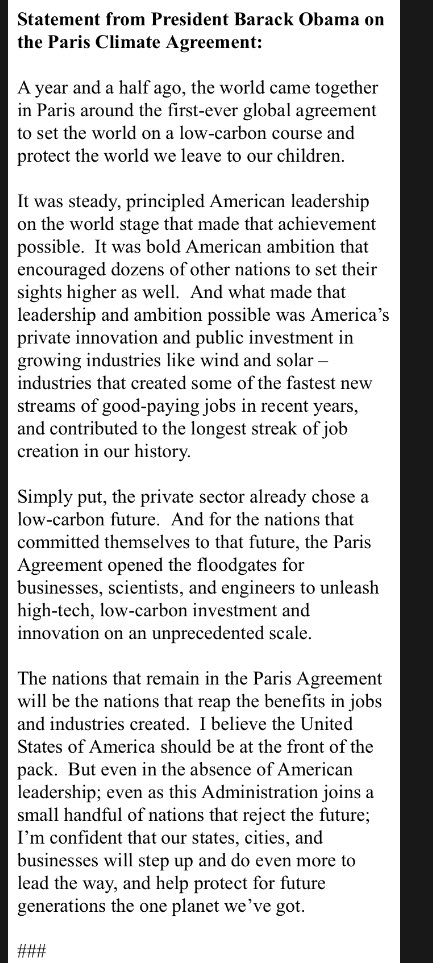
Latest:
http://heavy.com/news/2017/06/obama-paris-climate-agreement-withdrawal-statement-trump/
Dear members MDFDE, my fellow Americans,
Seriously? Our United States of America Withdrawing from Paris climate deal? Could it be?
As we all know, the Paris Agreement was adopted on 12 December 2015 at the twenty-first session of the Conference of the Parties to the United Nations Framework Convention on Climate Change held in Paris from 30 November to 13 December 2015. http://unfccc.int/paris_agreement/items/9444.php
There is simply no room, no way for some fool to renegociate while gorging on chocolate cake!
Let’s NOT be discouraged! Let’s NOT be divided! Let’s all defend Liberty “à la” BARTHOLDI!
As usual, CALIFORNIA, NEW YORK and WASHINGTON STATE did not wait a second to step up to the plate!
Here is how three BRAVE Governors – three 21st Century Musketeers – echoing President Obama, immediately showed the World what REAL LEADERSHIP is all about!
Hang tough Everyone! We Shall. We Will. Overcome. Adversity! All United! Long Live the United States Climate Alliance!
Yours faithfully,
Elisabeth Jenssen
#RESISTANCE
#PARISAGREEMENT
#U.S.CLIMATEALLIANCE
|
||||||||
| Governor Edmund G. Brown Jr. State Capitol Building Sacramento, CA 95814 |
From ancient Arles (800 BC) to The Statue of Liberty (1886) at Liberty Island, New York… We must also protect our world landmarks! E.J.
Operation Condor and the Statue of Liberty: two photography exhibits in Arles address freedom and repression
One day last summer at ‘Les Rencontres de la Photographie’ (The Arles Photography Festival), I saw two exhibits that in retrospect seem a dark premonition of today’s political ‘scape. Even their location, in a museum dedicated to fallen Roman rule seems prescient.
The shows were both presented at the ‘Musée départemental Arles Antique’, Arles’ Archaeology Museum. I’ve written about a previous visit to this striking place, and late one morning, I stepped out of the simmering Provencal sun into the Museum’s chilly expanse.
I’d come to see the show on the ground floor “Operation Condor”. Upstairs was a historical exhibit tracing the development and creation of the Statue of Liberty which I didn’t plan to see. She seemed settled history; what new could be learned there? In any case, I only had a few days in Arles; with scads of work to take in, “Lady Liberty” wasn’t a top priority. In retrospect, Liberty had a lot to say, and the pairing of the two exhibits was unexpectedly resonant.
“Operation Condor” presented the passionate work of Portuguese artist Joao Pina, who spent 10 years documenting its complexities. I went to see the show almost the way you might check in on an old acquaintance. Having spent time in the 1980’s heading a non-profit that promoted peace through people-to-people ‘citizen diplomacy’ during Nicaragua’s Contra war, I’d learned some about Latin American dictatorships and U.S. intervention. Operation Condor was notorious. A coordinated anti-communist program conducted against citizens by governments of six South American countries with support of the CIA. Tens of thousands of people were tortured and killed.
The installation was extremely dark. Life-sized, full-body mug shots of exiles lined the entrance walls. There were portraits; survivors of torture and imprisonment accompanied by stories of what they’d risen above in order to continue living. There were photographs of torture chambers, sites of mass death, and unmarked graves. Unspeakable pain.
Pina’s doggedness is evidenced in one photograph in particular. A plane mounted on a pole, angled above a lumberyard. He’d tracked it down. This plane was used by the Argentine security forces to transport tortured humans, living bodies they pushed out over the jungle or into the sea. Disappeared. Pina includes a photograph of the sea. Meditations on the depths to which some descend.
The exhibit followed a rough timeline – presenting near the end photographs from the trials of government and military leaders responsible for the torment. Years after perpetrating these crimes against humanity, they are sentenced, finally, to prison.
The show was an inspiring testament to survival and courage. What struck me was the life this history still held. How people keep going. It had seemed to me settled and in the past, but Pina’s message is that life goes on. The past keeps living in the present, and in the future of these people.
Diogenes Moura who curated the show describes the photographs as “outcries frozen in time”. Joao Pina’s “Operation Condor” unfreezes these stories into the present day.
On an impulse I decided to take a look at the show upstairs after all. “Lady Liberty” surprised me – bright expressions of shared optimism for enlightened democracy, paired against the dark repression and fear in the show below. Each of these exhibits, drawing in its way on humanity’s capacity for greatness and compassion – but from such opposite directions.
“Lady Liberty: the Photographic Making of an Icon” was curated by Luce Lebart and Sam Stourdze, the latter in his second year as director of the Rencontres. He’s put a mark on the festival that takes on big ideas, and the pairing of these two shows was brilliant.
There were many discoveries for me in the Liberty show. I’d not been aware of the numerous iterations she’d gone through, nor of sculptor Auguste Bartholdi’s obsession with bringing her to the world stage.
How Do You Save the Statue of Liberty From Drowning?
Lady Liberty is a towering symbol of our national vulnerability to the changing planet.
How do you save a 225-ton statue standing on a small island in New York Harbor from rising tides? First, you call someone like Jerry Matyiko of Expert House Movers Inc. of Maryland. He won’t hesitate when faced with the question of how to save the Statue of Liberty.
Forget about a barge, he said. The monument’s massive foundation and heavy stone pedestal would make it impractical to drag the structure away from Liberty Island. “We’re not going to move her,” Matyiko suggested, “we’re just going to jack her up on stilts and put her on a rotisserie, so New Jersey can stop bitching that she doesn’t face them.”
He’s one of the few with experience in monument relocation. The National Park Service called on him to solve a similarly complicated problem in the 1990s, when erosion threatened to drop a brick lighthouse at Cape Hatteras, N.C., into the Atlantic Ocean. The 4,800-ton landmark needed to be whisked away from the shore.
Matyiko worked with Joe Jakubik, a project manager at International Chimney Corp. in Buffalo, to devise a solution. The movers dug under the lighthouse, shifting its weight from the original granite foundation to a timber shoring system. Then they jacked the lighthouse onto rollers, taking care to make sure that gravity didn’t tear the brittle beacon apart. It took 30 days to roll the lighthouse to its new foundation, located a half-mile inland.
“You don’t set land speed records with lighthouses,” said Jakubik.
There’ll be plenty of demand in the years ahead for those with experience moving or protecting vulnerable coastal structures. Sea level rise could force millions of Americans to move from seaside communities by the end of the century, washing away hundreds of billions of dollars in real estate value. Cultural landmarks are similarly unprotected. More than $40 billion in National Park assets are located along coasts deemed “high exposure” risks, according to a 2015 survey published by the agency.
Lighthouses look easy compared with, say, a torch-bearing icon recognizable to almost everyone on the planet. So what should we do when the waters come for the Statue of Liberty?

The Statue of Liberty was fabricated in the late 19th century out of copper panels, each about the thickness of two pennies, fastened together and attached to an iron skeleton. The 150-foot monument stands atop an 89-foot stone pedestal, which in turn rests on a 65-foot foundation.
In her current position, with her toes about 154 feet above the waterline, Lady Liberty is better protected than many of her human neighbors. In one extreme scenario posited by the website Climate Central, melting ice sheets in Antarctica would cause sea levels to rise roughly 12 feet by 2100. That would be enough to produce average high tides 2 feet above the flood level caused by Hurricane Sandy, which swamped Liberty Island and destroyed its electrical systems.
If rising sea levels or increasingly violent storms were to one day trouble the base of the statue, New York Harbor will be facing plenty of other problems—including how to protect Manhattan’s million-plus residents and billions in real estate value. The city’s efforts to protect itself could even produce barriers that protect the harbor, although such a sea wall would be expensive to build.
More: https://www.bloomberg.com/news/features/2017-05-24/saving-the-statue-of-liberty-from-climate-change
